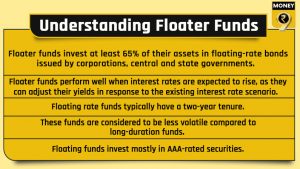Why is there hype in the market when it comes to floater funds?
As interest rates are expected to increase gradually in coming quarters, floater funds can benefit
- Himali Patel
- Last Updated : July 14, 2021, 18:11 IST

The last few months have witnessed many mutual fund houses launching floater funds. Four floater funds have been launched since the month of February 2021, which includes IDFC floating rate fund, DSP floater fund, Tata floating rate fund, and recently Axis mutual fund launched Axis floater fund. Traditionally, whenever the interest rate rises, the return on floater funds also increases as the funds predominantly invest in floating-rate instruments.
“Return from floater funds have always been close to the interest rate. It works well for those investors who do want to protect their capital from interest rate movement,” explained Harshad Chetanwala, co-founder, MyWealthGrowth.com.
How do floater funds work?
Floater funds invest at least 65% of their assets in floating-rate bonds issued by corporations, central and state governments.
These funds perform well when interest rates are expected to rise, as they can adjust their yields in response to the existing interest rate scenario. Floating rate funds typically have a two-year tenure and invest mostly in AAA-rated securities.
“In an interest rate environment which is set to change its trajectory on the upward direction, these funds are a suitable option. With the pick-up in the economy, inflation is seen up, which will eventually lead to a rise in interest rate environment,” said Manish Hingar, Founder of Fintoo.
Should you invest?
Market experts forecast that interest rates are expected to increase gradually in coming quarters, and currently, even high inflation would limit the scope of further lowering of interest rates. So, the benefit of increasing the interest rate is expected to be pass on to the floater funds.
“These funds invest their corpus in fluctuating interest-bearing debt securities. Historically, floater funds have given decent returns of about 8% at three-year compounded annual growth rate (CAGR) returns. These funds provide a suitable solution for short-term investors looking to navigate a possible rising rate environment,” pointed out Hingar.
So, who can consider investing in them?
“Investors with a low to medium risk profile wanting to park money for more than a year can consider investing in these funds,” added Hingar.

Being a debt fund category, the floater mutual fund attracts taxation on short and long-term capital gains.
Taxability criteria
Being a debt fund category, the floater mutual fund attracts taxation on short and long-term capital gains. If the fund was kept for less than three years, short-term capital gains tax (STCG) is applied in accordance with the individual’s income tax bracket. On the other hand, long-term capital gains taxes are charged on securities sold after holding them for at least three years. Such profits are taxed at a rate of 20% of total gains after indexation is applied.
Will this trend stay, or with the interest rate rising, this trend might fade away?
The risk is a bit higher when it comes to floater funds as other debt funds invest in instruments with different maturity periods depending on the type of debt fund.
“Investors should look at the portfolio of the fund and check the quality of holdings before investing as well. Like every debt fund except Gilt Funds, even floater funds can invest in debt instruments of private institutions along with the government. Hence floater funds do carry default or credit risk,” said Chetanwala.
Download Money9 App for the latest updates on Personal Finance.
Related
- पहली छमाही में रियल एस्टेट में संस्थागत निवेश 37% घटकर तीन अरब डॉलर रहने का अनुमान
- Budget’24: New LTCG rule to hit long-term property owners hard
- Looking to buy gold? Buy now before it’s too late!
- Budget 2024: What is NPS ‘Vatsalya’ scheme? How to apply & other benefits?
- Budget’ 24: Startup ecosystem all smiles with scrapping of angel tax
- Budget’24: New NPS scheme for minors launched, here’s how you can benefit

